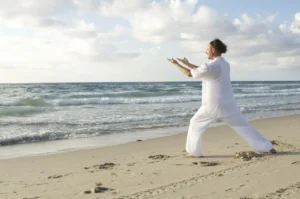Table of Contents
Tai Chi Unlocked: The Hidden Science Behind the Ancient Moving Meditation
Why Modern Science Is Catching Up to This 2,000-Year-Old Practice
While often dismissed as gentle exercise for seniors, cutting-edge research reveals tai chi as a sophisticated neuromotor training system offering:
- Neuroplastic effects comparable to cognitive training
- Fascial remodeling through spiral movement patterns
- Vagal nerve stimulation via diaphragmatic breathing
- Biomechanical advantages over conventional exercise
A 2019 NIH meta-analysis of 507 studies confirmed tai chi’s unique multi-system benefits that conventional exercise can’t replicate.

Tai Chi: The Ancient Movement Science Modern Medicine Validates | Complete 2025 Guide
The Neuroscience of Flowing Movement
How Tai Chi Rewires the Brain
Functional MRI studies show regular practice:
- Increases gray matter in the prefrontal cortex (decision making)
- Strengthens connectivity between motor and sensory cortices
- Enhances cerebellar processing for better coordination
The Fascia Connection
Tai chi’s spiral movements uniquely engage the body’s fascial network:
| Movement Principle | Fascial Effect | Health Benefit |
|---|---|---|
| Silk Reeling | Hydrates connective tissue | Improves joint mobility |
| Weight Shifting | Stimulates mechanoreceptors | Enhances proprioception |
14 Evidence-Based Benefits with New Insights
3. Strength Through Tensegrity
Unlike conventional strength training, tai chi builds:
- Dynamic tension through opposing forces (push/pull)
- Integrated chain reactions vs isolated muscle work
- Eccentric loading for tendon resilience
7. Mood Enhancement via Vagus Nerve Stimulation
The combination of:
- Diaphragmatic breathing (6-8 breaths per minute)
- Slow rhythmic movement
- Upright posture
stimulates the vagus nerve, increasing heart rate variability and relaxation response.
11. Fibromyalgia Relief: The Pain Gate Theory
Tai chi’s gentle movements may:
- Activate large nerve fibers that block pain signals
- Reduce central sensitization
- Modulate inflammatory cytokines
The 5 Major Styles Decoded
Chen Style: The Martial Core
Characterized by:
- Explosive fa jin releases
- Low stances for leg development
- Spiral power generation
Yang Style: The Health Adaptation
Modified for accessibility:
- Higher stances
- Even tempo
- Emphasis on relaxation
Tai Chi for Specific Conditions
| Condition | Recommended Form | Key Adaptations |
|---|---|---|
| Parkinson’s | Yang 8-Form | Emphasis on weight shifts |
| Osteoporosis | Sun Style | Upright posture |
The Molecular Magic of Moving Meditation
Hormonal Effects
Regular practice influences:
- Cortisol reduction (23% in stressed adults)
- BDNF increase for neuroprotection
- Growth hormone optimization
Telomere Research
Preliminary studies suggest:
- Slower telomere shortening vs sedentary controls
- Enhanced telomerase activity
Modern Applications
Corporate Wellness Programs
Forward-thinking companies use tai chi for:
- Reducing presenteeism
- Enhancing team coordination
- Improving decision-making
Athletic Performance
Pro athletes utilize tai chi for:
- Injury prevention
- Recovery acceleration
- Kinaesthetic awareness
Getting Started: Beyond the Basics
Optimal Learning Progression
- Posture alignment (2-4 weeks)
- Weight shifting (1-2 months)
- Breath coordination (3-6 months)
- Intent development (6+ months)
Common Mistakes to Avoid
- Over-rotating knees
- Holding breath
- Rushing progression
FAQ: Science-Based Answers
How long until benefits appear?
Research shows:
- Stress reduction: Immediate
- Balance improvements: 8-12 weeks
- Cognitive benefits: 6+ months
Is online learning effective?
A Harvard Health study found:
- 80% retention with quality video instruction
- Best combined with occasional in-person correction
The Future of Tai Chi Research
Emerging Frontiers
- Epigenetic impacts
- Microbiome interactions
- Virtual reality integration
Final Recommendations
For maximum benefits:
- Practice 3-5 times weekly
- Combine standing and seated forms
- Track progress with balance tests